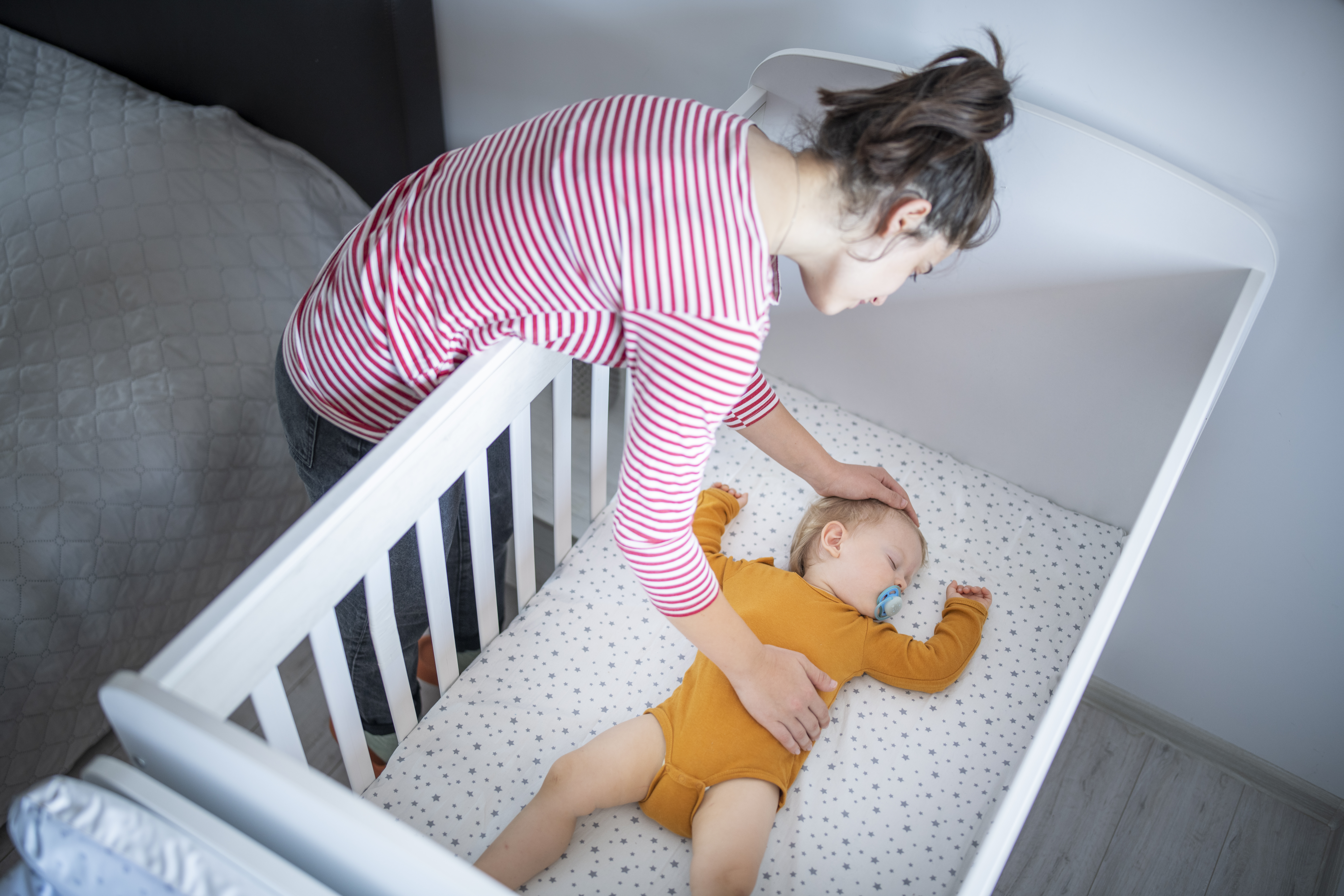 Return to Articles
Return to Articles
2.21.2024
Safe Sleep for Your Baby

Every day, families around the world welcome a new baby into their lives. They face joys and challenges in helping baby stay safe and healthy. Still, thousands of babies die suddenly and unexpectedly in the United States each year – often while they are sleeping.
Different groups use different terms to describe the death of a baby during sleep, such as:
- Sudden Unexpected Infant Death (SUID) – This broad term describes all sudden, unexpected infant deaths, including those from a known cause, like an injury, and those from unknown causes.
- Sudden Infant Death Syndrome (SIDS) – SIDS is a sudden, unexpected death of a baby younger than 1 year of age that doesn’t have a known cause even after a full investigation.
- Other Sleep-Related Deaths – This term describes deaths from something in or related to the baby’s sleep environment, how or where the baby sleeps, or things that happen during sleep. Other sleep-related deaths occur when baby can’t breathe, such as from:
- Entrapment or wedging: Baby’s body or head gets stuck between two objects, like a mattress and wall, bed frame, or furniture
- Suffocation: Something, such as a pillow or adult’s arm, covers baby’s face or nose
- Strangulation: Something presses on or wraps around baby’s neck
No matter what it is called, the death of a baby during sleep is a tragedy. The actions described here can help parents and caregivers reduce baby’s risk of SUID, SIDS, and other sleep-related deaths.
Parents and caregivers can help protect baby during sleep by creating a safe sleep environment.
We have made great progress in saving infant lives. The number of U.S. babies who die during sleep is much lower today than it was during the 1990s, when education and awareness efforts started.
But unsafe sleep environments remain a deadly problem for U.S. babies, and the risk of death during sleep remains higher in Black/African American and American Indian/Alaska Native babies than in White, Hispanic, or Asian/Pacific Islander babies.
Five Steps to Keeping Your Baby Safe During Sleep
1. Place babies on their backs to sleep for naps and at night.
- Place all babies – including those born preterm and those with reflux – on their backs to sleep until they are 1 year old.
- It is not safe to place babies on their sides or stomachs to sleep, not even for a nap. The safest sleep position is on the back.
- Babies who sleep on their backs are at lower risk for SIDS than babies who sleep on their stomachs or sides.
- If baby usually sleeps on their back, putting them on the stomach or side to sleep, for a nap or at night, increases the risk for SIDS by up to 45 times.
- Once babies can roll from back to stomach and from stomach to back on their own, you can leave them in the position they choose after starting sleep on their back. If they can only roll one way on their own, you can reposition them to their back if they roll onto their stomach during sleep.
2. Use a sleep surface that is firm (returns to original shape quickly if pressed on), flat (like a table, not a hammock), level (not an angle or incline), and covered only by a fitted sheet.
- Both the sleep surface (such as a mattress) and the sleep space (like a crib, bassinet, or portable play yard) should meet the safety standards of the Consumer Product Safety Commission (CPSC). The CPSC offers more information about mattresses and crib safety at https://bit.ly/CPSCSafeSleep.
- Soft surfaces – like couches, sofas, waterbeds, memory foam, air and pillow-top mattresses, quilts, blankets, and sheepskins – are not safe for babies to sleep on. Sleeping on soft surfaces raises baby’s risk of wedging or entrapment, suffocation, and strangulation.
- Inclined or tilted sleep surfaces, with one end higher than the other, are not safe for babies to sleep on because baby’s body can slide down, which could block their airway and breathing.
- Do not use sitting devices, such as car seats and strollers, or carrying devices, like carriers and slings, for baby’s regular sleep area or for naps. If baby falls asleep in one of these devices, move them to their regular sleep space as soon as possible once you are out of a vehicle. The American Academy of Pediatrics offers travel safety tips (https://bit.ly/AAPTravelSafety), such as giving baby breaks from the sitting device every few hours.
- Avoid letting baby sit slumped over, like with their chin on their chest, because it could block their airway and breathing. Young babies and those unable to control their head and neck muscles risk suffocation and death from sitting this way.
- Keep comforters, quilts, pillows, and blankets out of baby’s sleep area.
3. Share your room with baby, not your bed, for at least the first 6 months.
- Give babies their own sleep space (crib, bassinet, or portable play yard) in your room, separate from your bed.
- Babies in their own sleep space are at lower risk for injury and death from SIDS and from situations like an adult or sibling accidentally rolling over them.
- Room sharing by putting baby’s sleep space near, but not in, your bed is safer than sharing your bed with baby. Sharing your room with baby is also safer than putting baby in their own room.
- Keeping baby’s sleep space close to your bed makes it easy to check on, feed, and comfort baby without having to get all the way out of bed.
- If you are bringing baby into your bed for feeding or comforting, before you start, remove or clear away all soft items and bedding from your side of the bed. This practice may help prevent suffocation in case you fall asleep. When finished, put baby back in their own sleep space close to your bed.
- If you fall asleep while feeding or comforting baby in your bed, put them back in a separate sleep area as soon as you wake up. Research shows that the longer an adult shares a bed with baby, the higher baby’s risk for suffocation and other sleep-related death.
- Couches and armchairs are never safe places for babies to sleep. These surfaces are extremely dangerous when an adult falls asleep while feeding, comforting, or snuggling with baby. Do not let babies sleep on these surfaces alone, with you, with someone else, or with pets.
4. Feed baby human milk, like by direct breastfeeding.
- In most cases, pediatricians and other health care providers recommend feeding only human milk, with nothing added, if possible, for at least baby’s first 6 months. Babies born preterm or with certain health conditions may need different care.
- Feeding babies human milk by direct breastfeeding, if possible, or by pumping from the breast, reduces the risk of SIDS. Feeding only human milk, with no formula or other things added, for the first 6 months provides the greatest protection from SIDS.
- Feeding baby any human milk, even with other foods added, is more protective than not feeding them human milk at all.
- The longer a baby gets human milk, the lower the SIDS risk.
- Feeding human milk also has other benefits for babies, such as reduced risks of diarrhea, asthma, and ear infections.
5. Keep things out of baby’s sleep area – no objects, toys, or other items.
- Remove everything from baby’s sleep area except a fitted sheet covering the mattress.
- Things in the sleep area can pose dangers for baby, especially if they are:
- Soft or squishy (pillows, stuffed toys, crib bumpers)
- Under or over baby (comforters, quilts, blankets, positioners)
- Non-fitted, even if lightweight, small, or “tucked in” (loveys/cloths, non-fitted sheets, tucked in blankets)
- Weighted (weighted blankets, weighted swaddles, weighted objects)
- Research links crib bumpers and bedding other than a fitted sheet covering the baby’s mattress to serious injuries and death from SIDS, suffocation, entrapment, and strangulation.
For more information on safe sleep, including more tips to keep your baby safe and healthy, visit Safe to Sleep® at https://safetosleep.nichd.nih.gov/.
Article adapted from the Safe to Sleep® booklet: Safe Sleep for Your Baby: Reduce the Risk of Sudden Infant Death Syndrome (SIDS) and Other Sleep-Related Infant Deaths. January 2023.






